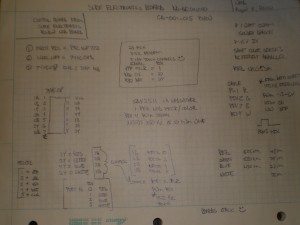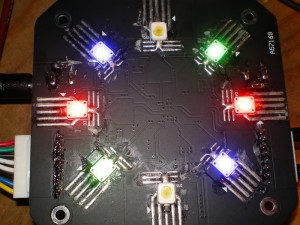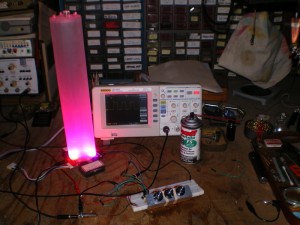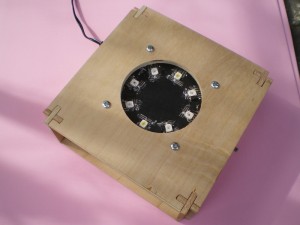After spending a bunch of time playing around with high output surface mount leds from lumex, designing a board and running tests etc… I stumbled on this interesting led module being sold on ebay by a seller named Sure Electronics. I’ve gotten stuff from them before, usually turns out good, and this was all told 10.00 dollars or so shipped. It looked like it came with a control board, and from looking at the photos, it appeared to be a bog standard, PIC micro, so… What the heck, worth a play…

Ordering stuff from China is kind of fun, you place your order and then just forget about it, one day a package shows up and, surprise, you say to yourself “Hello, whats this???, Did I order something???” Then you open it up and hopefully remember.
The module looked pretty good out of the box, coated circuit board, seemed high quality, LEDs were soldered on by hand or so it looked and some other components as well. There is obvious flux residue around these but still, not a bad board. I had to bring my own 12 volt supply to the party but the module fired up and worked. You get 2 each red, blue, green and white 1 watt LEDs. All the step down chips, inductors and support components to drive them at a high voltage with some efficiency.
You also get a controller board that features a 28 pin PIC16F722 with 3 ports broken out to holes for headers and even the programming pins are brought out to another row of holes where you can easily solder on a header and hook up a PicKit2 programmer. Ten minutes or so with the soldering iron and I had it wired up to the programmer.

Some time with a volt meter revealed that the LEDs were wired back to the PIC through an 74HC08 AND gate, essentially one side of all the and gates are common and go to a PWM pin. The other side of each AND gate goes to an individual pin on the PIC. Essentially the way the board is set up you can turn each set of two LEDs on individually and you can dim the whole module.
After some modification my RGB color wheel subroutine was going and I was able to to switch colors by number. Basically its a PWM routine that divides the standard RGB color wheel into 255 pieces, so it works with 8 bit numbers. Then in code all you have to do is give it a number between 0 and 255 an it will do the correct PWM to give you that color from the display. It took me a while to figure this out, but I have it down to a pretty nice little routine now, and use it with all my RGB stuff.
Here is a drawing of what I reverse engineered from the board. Unfortunately as of this writing I don’t think these are available anymore.
and… a couple of more shots of it lighting up the bench…
After a long while I managed to get it all boxed up 😉 Its mounted in a small CNC’d box with a slider on the side to change the color. A friend is going to use it in photography to color shadows on small scenes.



